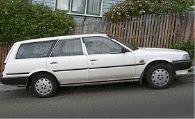A. Put the handbrake on and put the transmission in "P" (park).
 Check all that apply. You want to leave your automatic car parked on a street sloping uphill. You should:
Check all that apply. You want to leave your automatic car parked on a street sloping uphill. You should:
A. Put the handbrake on and put the transmission in "P" (park).
B. Park only on flat areas.
C. Turn the wheels away from the kerb.
When you park facing uphill there will be forces (gravity) trying to make the car roll back downhill.
In an automatic car you should put the gearbox in P (park), put the handbrake on and turn the wheels towards the kerb. This means that if the car does roll at all the wheel angle will steer the car towards the kerb and it will rest against the kerb.
If you are driving a manual car then you would apply the handbrake, put the car in first gear because this will give more engine resistance if the handbrake fails, and turn the wheels towards the kerb.
When you park, think about what vehicle will be in front of you and whether it's likely to roll back - have you left it enough room? Generally it's easier for drivers of newer vehicles to get out of tighter parallel parks because they are likely to have reversing sensors and/or cameras, and hill hold (an electronic brake that stops a car rolling backwards).
When you go to pull away from the kerb, remember that you will need to have more revs if you are in a manual car as you have to counter the effects of gravity. Use your handbrake to hold the car from rolling back. Indicate and check over your shoulder before you move out to make sure that it's safe.
If you are parking downhill, leave manual car in reverse gear, rather than first gear. Turn the wheels towards the kerb so that if the car rolls forwards it rests against the kerb rather than turning into the traffic lane. An automatic car should be left in P with the handbrake on.